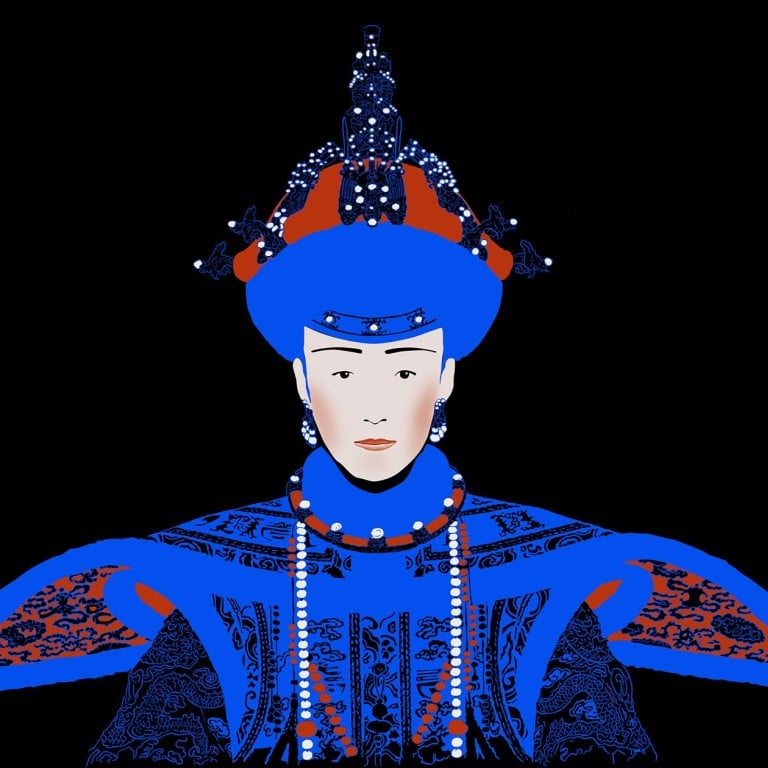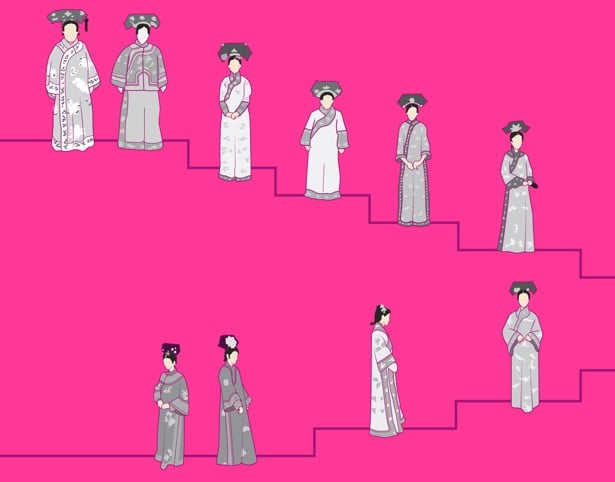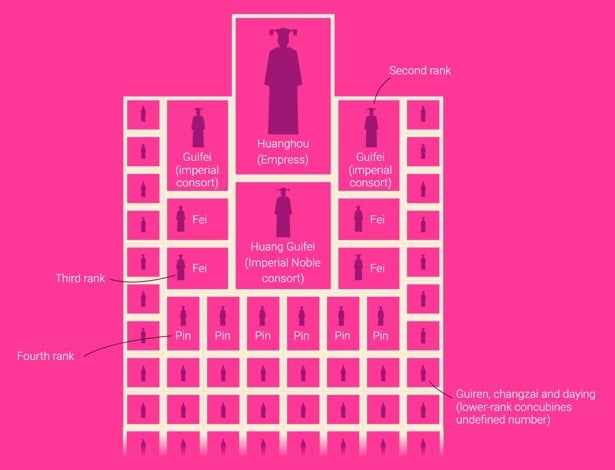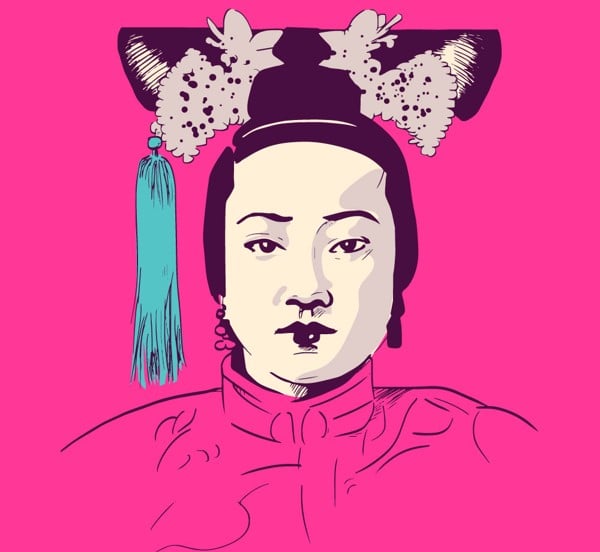
For Forbidden City concubines in imperial China, beauty was more of a curse than a blessing
- A select group of concubines was tasked to bear children for the emperor – as many as he could father
- Most would spend their lives in bitter loneliness and, unsurprisingly, jealousy was rife
All women living in the Forbidden City were carefully sequestered in the imperial quarters deep inside the palace. They were restricted to the inner court and forbidden from venturing out of the northern section.
Most women in the Forbidden City were employed as maids and servants, but there was also a select group of concubines whose task was to bear children for the emperor – as many as he could father. Those who gave birth to male offspring were elevated to imperial consorts, with the empress at the top of the pecking order.
Women were selected as xiunu (elegant females) for the court as early as the Jin dynasty (265-420 AD) and the selection criteria ranged from emperor to emperor. In the Ming dynasty, for example, no household was exempt from the selection. According to statutes, all young unmarried women went through xiunu selection process. Only girls who were married or with certified physical disabilities or deformities were exempt.
But the Qing Emperor Shunzhi (1638-61) began to exclude most of the Han population by limiting selection to “Eight Banners” families, who were mainly Manchurian and Mongolian. (Eight Banners was a Manchurian administrative and military framework.)
The Board of Revenue sent notices to officials in the capital and provincial garrisons to enlist the help of clan heads. The banner officials then submitted a list of all available females to the commanders’ headquarters in Beijing and to the Board of Revenue.
Requirements for selection
During the Qing dynasty, girls were brought on the appointed day to the Shenwu (Martial Spirit) Gate of the Forbidden City for inspection. They would be accompanied by their parents, or nearest relatives, together with their clan heads and local officials.

Social background was no barrier and many emperors chose concubines from the general public. The empress was one exception – she was always selected from the family of a high-ranking official.
Fewer than a hundred of the candidates would be selected to spend several nights with women who specialised in training and managing maids. Candidates’ bodies were inspected for skin infections, body hair, body odour and other things.
The finalists were initiated into forms of acceptable behaviour and how to speak, gesture and walk. They also learned arts such as painting, reading, writing, chess and dancing.
Finally, the stand-out candidates spent several days serving as maids to the emperor’s mother, taking care of her daily needs. They underwent further inspections while sleeping by the mother’s side to root out any bad nocturnal habits, such as snoring, emitting odours or talking or walking in their sleep.
The outstanding 50

In 1621, Ming Emperor Tianqi sent eunuchs across the country to handpick 5,000 young women aged 13 to 16, from whom he would select a wife.
During the first round of the competition, the women stood in lines of 100 according to age. One thousand were eliminated for being too tall, short, fat or thin.
On the second day, the eunuchs intensively examined the women’s bodies and evaluated their voices and manner. This slimmed down the field by another 2,000.

The third day was spent observing their feet, hands and grace of movement. Another 1,000 were eliminated. The remaining 1,000 underwent gynaecological examinations, dismissing another 700 from the process.
The remaining 300 were then housed in the palace where they underwent a month-long series of tests of intelligence, merit, temperament and moral character.
The top 50 candidates were subject to further examinations and interviews about mathematics, literature and art, and ranked accordingly.

The three favourites would receive the highest ranking for imperial concubines.
Only a few of those who made it through this rigorous process would be noticed by the emperor and win his favour. Most would spend their lives in loneliness and, unsurprisingly, jealousy was rife. Beauty was more of a curse than a blessing in China during this period of history.
Activities
Naturally, concubines were strictly forbidden from having sex with anyone other than the emperor.
Most of their activities were overseen and monitored by eunuchs, who wielded great power in the palace. Concubines were required to bathe and be examined by a court doctor before the emperor visited their bed chamber.
With hundreds, sometimes thousands, of concubines at the emperor’s disposal, any lady the emperor graced with a visit would be subject to jealous rivalries. Concubines had their own rooms and would fill their days applying make-up, sewing, practising various arts and socialising with other concubines. Many of them spent their entire lives in the palace without any contact with the emperor.
Hierarchy
In the Qing dynasty harem system, the ranking remained consistent but the number of consorts and concubines varied under different emperors.

On the same level were the empress (Huanghou), the emperor’s principal wife, and the empress dowager, a title given to the mother, or widow, of an emperor. The dowager lived in the reigns of at least two subsequent emperors.
One step down in rank was the imperial noble consort (Huang Guifei), who ranked second to the empress. Only one consort in the harem could hold this title.
Below her were the imperial consorts (Guifei). The imperial harem had two women with this title. Following them were the consorts (Fei). Four women in the imperial harem held this title.
Next were the imperial concubines (Pin). There were six women in the imperial harem with this title.
The harem also had an unlimited number of attendants. These three ranks of women – first-class, second-class (higher) and second-class (lower) female attendants – did not have their own palaces and lived communally instead.

Polygamy
Polygamy was common practice in feudal China, although only upper- and wealthy middle-class men could afford to take several wives. It was seen as an affirmation of male potency, and the presence of many women was taken to indicate a man’s virility.
The emphasis was on procreation and the continuity of the father’s family name. Confucianism emphasised the ability of a man to manage a family as part of his personal growth in daxue (great learning). In the case of the emperor, guaranteeing a successor to the throne was of paramount importance.
The four principles of polygamy in feudal China were:
1. The strict distinction between main wife and concubines
The main wife was superior to all other wives. She was responsible for submitting to the higher principles of polygamy and to mentor the other wives in harmonious behaviour for the greater good.
2. Women must not be jealous
Women, especially the main wife, had to rise above their earthly emotions. The belief that they were living for a higher purpose presumably helped displace feelings of bitterness, jealousy and rivalry.
3. Attachment could radically destabilise polygamy
The husband should not have a favourite, nor should any of the wives monopolise the man. Love had to be distributed evenly among the wives, which effectively meant that passionate attachment was not acceptable.
4. Polygamy could only survive by observing a strict hierarchy
Each dynasty had its own set of titles and ranks for the imperial wives. The empress ranked at the top, with more wives filling successive echelons below her. Most wives occupied the lower echelons. Hierarchy was determined at specific times, such as when a new wife joined the imperial family and was assigned a rank.

Emperor’s sexual rotation
It was believed that organising the emperor’s sex life was essential to maintaining the well-being of the entire Chinese empire. The Chinese calendars of the 10th century were not used to keep track of time but rather to keep the emperor’s sex schedule in check. The rotation of concubines sleeping with the emperor was kept to a regimented order. Secretaries were employed to record the emperor’s sex life with brushes dipped in imperial vermilion.
Moon cycle
In China, and some other Asian countries, age is determined from the moment of conception, not the moment of birth. The Imperial Chinese believed that women were most likely to conceive during the full moon, when the Yin, or female influence, was strong enough to match the Yang, or male force, of the emperor.
The empress and other wives slept with the emperor around the time of the full moon because it was believed children of strong virtue would be conceived on those nights. The lower-ranking concubines were tasked with nourishing the emperor’s Yang with their Yin, sleeping with him around the time of the new moon.
The fate of a favourite

Zhenfei entered the palace in 1899 during the Guangxu reign at the age of 13. She was later promoted to the title of imperial concubine, second to Empress Longyu, who was the niece of Empress Dowager Cixi. Zhenfei was a beautiful and intelligent woman. As the Guangxu emperor’s favourite consort, she gained much influence in the imperial court. Popularly known as the “Pearl Consort”, she hated rules and regulations. She was prone to acts of rebellion which infuriated Cixi, who began to look for an excuse to punish her.
On June 20, 1900, the Eight-Nation Alliance laid siege to Beijing and Cixi forced the emperor to flee with her to Xian. Before they left, Cixi ordered Zhenfei to commit suicide on the pretext that her youth and beauty would endanger the royal party as well as bring shame if she were raped by foreign soldiers. Zhenfei refused, asking instead for an audience with the emperor. It is believed Dowager Cixi responded by ordering eunuchs to throw Zhenfei to her death down a well behind the Ningxia Palace.

